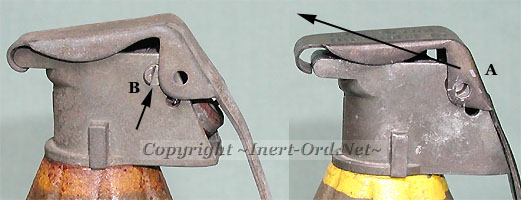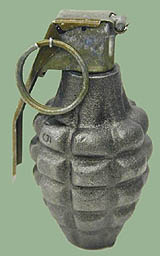
The "mouse trap" fuze design, developed for the Mk.II
in 1918, proved to be one of the most successful grenade fuze concepts.
This type is widely used on American grenades as well as copied, in one form
or another, by many other nations.
Its function is simple, cheap to make and reliable.
During the early years of WWII there were some problems with the fuze however. One was the flash from the primer sometimes blew past the delay fuse into the detonator directly, resulting in premature detonation. In tropical environments there was moisture entrapment under the foil seal. When used, there was a loud report, flash and smoke issued from the fuze vents, which attracted unwelcome attention in battle. So it is understandable that the Mk.II fuze went through a number of changes, accounting for the the different fuze markings found: M10, M10A1, A2 and A3, as well as the M6 series. The external physical appearance of the fuze remained constant as the changes were internal.
Fuzes are marked on the lever by metal stampings or black ink. Some are unmarked while others are metal stamped with one type and subsequently ink stamped with another identification.
The M10 series is the most common found.
Its function is simple, cheap to make and reliable.
During the early years of WWII there were some problems with the fuze however. One was the flash from the primer sometimes blew past the delay fuse into the detonator directly, resulting in premature detonation. In tropical environments there was moisture entrapment under the foil seal. When used, there was a loud report, flash and smoke issued from the fuze vents, which attracted unwelcome attention in battle. So it is understandable that the Mk.II fuze went through a number of changes, accounting for the the different fuze markings found: M10, M10A1, A2 and A3, as well as the M6 series. The external physical appearance of the fuze remained constant as the changes were internal.
Fuzes are marked on the lever by metal stampings or black ink. Some are unmarked while others are metal stamped with one type and subsequently ink stamped with another identification.
The M10 series is the most common found.


Fuze Mechanical Variation
The curved, fold-over hinge, safety lever design was used for about 25 years but it had an inherent problem. Under certain grip conditions, the striker can push the lever forward and off the hinge lip ("A"). Without the hinge engaged the lever can swing back, pivoting at the palm, releasing the striker with the grenade still held in the hand.
A quick modification to correct this was a striker pivot pin which extends beyond the bouchon wall. With a flat cut in it ("B") a lever stop is created. This prevented the lever from slipping forward. An interesting fuze feature to look for.
A better solution was the creation of the modern split-toggle hinge design developed at the end of the war and commonly found on modern fuzes.

 M21(Post WWII Fuze) - Mk.II - M21 (Re-painted)
M21(Post WWII Fuze) - Mk.II - M21 (Re-painted) A common misrepresented "Mk.II" type found currently.
A common misrepresented "Mk.II" type found currently. Here appears to be a vintage M21 with yellow paint added and "aged".
Here appears to be a vintage M21 with yellow paint added and "aged".
